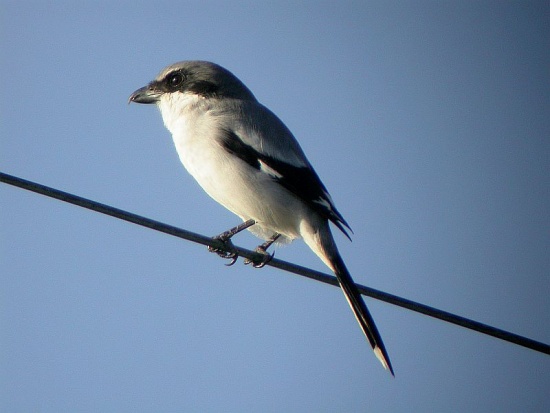Nutcracker (talk | contribs) (more details) |
Nutcracker (talk | contribs) m (format error) |
||
| Line 3: | Line 3: | ||
==Identification== | ==Identification== | ||
| − | Length 18-22 cm, weight 43-54 g<br> | + | Length 18-22 cm, weight 43-54 g<br /> |
Gray head and back, white under parts, broad black face mask extending narrowly across above the bill, black bill. Wings and tail black with white flash at base of primaries; scapulars gray with white tips (white varying in width between different subspecies). Juvenile finely barred. | Gray head and back, white under parts, broad black face mask extending narrowly across above the bill, black bill. Wings and tail black with white flash at base of primaries; scapulars gray with white tips (white varying in width between different subspecies). Juvenile finely barred. | ||
====Similar species==== | ====Similar species==== | ||
Revision as of 23:46, 13 December 2014
- Lanius ludovicianus
Identification
Length 18-22 cm, weight 43-54 g
Gray head and back, white under parts, broad black face mask extending narrowly across above the bill, black bill. Wings and tail black with white flash at base of primaries; scapulars gray with white tips (white varying in width between different subspecies). Juvenile finely barred.
Similar species
Northern Shrike differs in being slightly larger and longer-tailed, and with the black mask never extending onto the forehead.
Distribution
North America (north to south-central Canada) and Mexico. Populations in south, west, and east USA resident, those in north-central USA and Canada migrate a short way south in winter. Canadian and eastern populations declining; no longer breeding in the northeast US, where now a scarce passage visitor.
Taxonomy
Eleven subspecies are recognized[1]:
- L. l. gambeli
- L. l. excubitorides
- L. l. migrans
- L. l. sonoriensis
- L. l. anthonyi
- L. l. mearnsi
- L. l. grinnelli
- L. l. nelsoni
- L. l. ludovicianus
- L. l. miamensis
- L. l. mexicanus
The subspecies differ mainly in the tone of gray; generally darker in the south of the range and paler in the north, but southern Florida birds also pale.
Habitat
Semi-open areas with scattered shrubs and rough grass; also uses fence lines and utility poles in low-intensity agricultural land.
Behaviour
They nest in a dense tree or shrub. The female lays 4 to 8 eggs in a bulky cup built from twigs and grass.
Diet includes large insects, also rodents and small birds.
References
- Clements, JF. 2011. The Clements Checklist of Birds of the World. 6th ed., with updates to August 2011. Ithaca: Cornell Univ. Press. ISBN 978-0801445019. Spreadsheet available at http://www.birds.cornell.edu/clementschecklist/downloadable-clements-checklist




